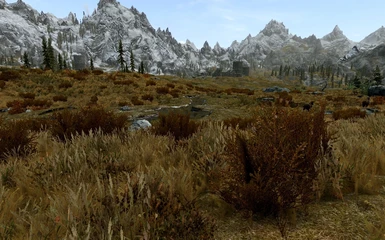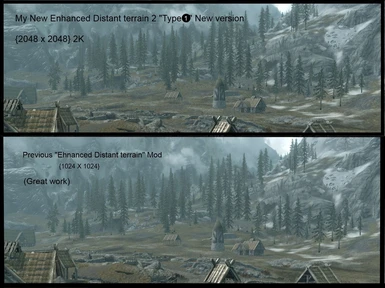Available safety features vary by model. See dealer for details. Safety or driver assistance features are no substitute for the driver’s responsibility to operate the vehicle in a safe manner. The driver should remain attentive to traffic, surroundings and road conditions at all times.
Enhanced Distant Terrain 2
I'm currently looking into fixing the snow up, but because I can't find anything that can remove the speckles from the white areas on the fly, it looks like a totally manual job. Just put it on hold until I can come up with something.:) Thanks. I may remove Dragonborn because it's almost always dark there and most of the LOD textures are seemingly just blank - also not much elevation to see the effect.

I did originally try to just edit the normals, but just a slight increase in depth makes them look awful. They seem to be model space (used on characters in this game) normals instead of tangeant based (used on almost everything) too. Applying new tangeant space normals makes the terrain black. SparrowPrince just released a new release of EDT. I really like the grass noise version.color=#ffda00 (grass version only apples to EDT' date=' which is only the noise texture. These are the terrain textures)/color'See gallery for all DT compares:Who did those compares and what textures were being used in the Whiterun scene? I swear they don't look like vanilla.Thanks for your work phazer.
I recommend 'Revamped Exterior Fog' because it makes the differences a lot clearer. That vanilla smog in the background just ruins everything. I have over 600 files to get through and each texture requires multiple actions and me opening different windows. I will bump this thread when I have done.:)No problem.Also to everyone here is the link to my existing distance compares gallery. I did the compares using vanilla with some of the proposed Core mods for context (No Stretching, SMIM, SRO, AOF Mountains, Terrain Bump, TreesHD).
I have been doing a lot of compares recently and keeping notes in the. They are limited and not based on standard protocol, but I do think that they illustrate the differences pretty well (there is only so much distant terrain that can be captured in a landscape screen).Definitely put up some better compares. I was only stoking the flames a bit.Recent Core compare galleries (these are based on pure vanilla with Sec D 'fixes' only):EDIT: I wnet in and tried to get some screens without the added mods proposed for Core, and the snow textures had a lot of undesireable tiling. This goes to show that we will need to get screens for some compares in the proper context. Therefore, I think that LOD, terrain and landscape-based mods should be tested against the background of our best estimate of STEP:Core, which can be referenced by looking at the current guide, current changelog and dev changelog.I am getting more screens now for this one.EDIT2: SRO fixes the snow tiling.EDIT3: This mod also completely overwrites 'A Quality World Map', so we'll want to account for that in the load order if we pick this one up (unless we simply instruct users to remove those textures from this mod)@SparrowThanks for responding to this;) We'll keep an eye on this one. The gallery link in the OP now provides a much more comprehensive gallery of compares across landscapes.

Note that this mod (EDT2) appears as the 6th image in each set. I think that this mod makes the terrain blend better with the near-distant terrain (evidenced by the first set (06) and the 6th set (56)). The only issue is those snow LODs that Sparrow has already conceded.I have included a list of installed background mods in the gallery. I think that these are necessary to fairly judge all distance mods for Core.EDIT: I see not that I had Tobes active. This is not necessary.
Skyrim Enhanced Distant Terrain 2
I just forgot to uninstall it. Also meant to have Realistic Tundra Moss installed, but forgot that too:P. The last shot (compare #7) is Enhanced Distant Terrain with the LODs from HQ LODs (hi meshes, SRO-512 textures).
Skyrim Enhanced Distant Terrain 2
I think that the 6th compare is best (EDT-Earth+EDT2), particularly with respect to the first set over Whiterun. Notice how much better the LOD matches the foreground terrain color with grass.
It is difficult to see where grass ends and LOD begins. Very nice blending I think.This would mean that you do not prefer EDT2 then?EDIT: Just noticed that I had neglected to install SFO Basic before creating these compares. I will need to redo them ALL. I will also be adding in Detailed Terrain & Tree LOD, which conflicts with EDT noise and SFO. Stay tuned. quote name='techangel85' pid='48884' dateline='Upon a second review' date=' I meant the 6th compare is the best.
I'm curious to know how the HQLODs look installed with/over this (however it would be installed in STEP) if it wasn't already with the 6th shot./quote'HQ LOD meshes are in all shots, but the HQ LOD SRO terrain textures only appear int he 7th set. There is really no difference in any of these compares when using the HQ LOD SRO terrain textures, since they appear to match vanilla in all of these shots.I am redoing the whole thing (see prev post) and will eliminate compares with the HQ LOD SRO terrain textures and add DTTL to the mix, so check back in an hour or so.
Whenever an airplane is functioning properly but nonetheless slams into terrain, either because it is off course or because the pilot has lost track of his position, the technical term is “controlled flight into terrain”—CFIT, pronounced “SEE-fit.” Around the world, about four flights succumb to CFIT each year. Investigators recently found CFIT to be a factor when a Fokker F-28 slammed into a cloud-covered mountaintop in Peru last January 9, killing all 47 people aboard.The Federal Aviation Administration attempted to reduce the incidence of CFIT by mandating in 1974 that aircraft operate with Ground Proximity Warning Systems (GPWS). But the systems had limitations. GPWS relied on the airplane’s radio altimeter, which determines the aircraft’s altitude by bouncing a radar signal off the ground and measuring the duration of the signal’s round trip. “The sensor was looking straight down,” says Greg Francois of Honeywell Aerospace. “If you were going into very steep terrain, then you got a very short warning”—10 to 15 seconds or less.

And GPWS cockpit displays were crude; their sole visual warnings were lights. Even with GPWS, the pilot of that F-28 still flew his airplane into a mountain.Today the FAA is banking on an improved technology: the Terrain Awareness and Warning System. The agenccy requires that in the United States, all new airliners (and by 2005, most older ones) be equipped TAWS. The new technology has the ability to look notjust down but also ahead, so that the crew can get a longer warning of possible CFIT: 30 to 120 seconds.
And for visual warnings, TAWS gives detailed pictures of significant terrain.TAWS uses the Global Positioning System to determine the aircraft’s position, ground speed, and ground track. That data, along with the aircraft’s altitude, are fed into a computer in the airplane. The computer has a database on the world’s natural terrain, man-made obstacles, and runways.When the airplane’s position and flight path are superimposed on the database of the relevant area, the results are rendered as detailed visual representations of significant terrain and obstacles around the craft. The images appear either on a dedicated monitor or on the aircraft’s weather radar screen (in which case the pilot can toggle between weather and terrain displays).Some manufacturers’ systems go farther, analyzing the flight plan in the aircraft’s flight management system computer and plotting potential hazards along the entire route.Today’s TAWS monitors show terrain below the aircraft’s altitude as green or black, terrain near the aircraft’s altitude as yellow, and mountains or other terrain well above the aircraft’s altitude as red. When the aircraft is descending, the colors represent distances above or below its projected glideslope. When the aircraft is a minute or so from flying into the ground, the TAWS gives both visual and aural warnings.TAWS uses the same warning modes that were used in the older GPWS:.
Mode 1 warns of an excessive descent rate during landing or whenever the aircraft is close to the ground.